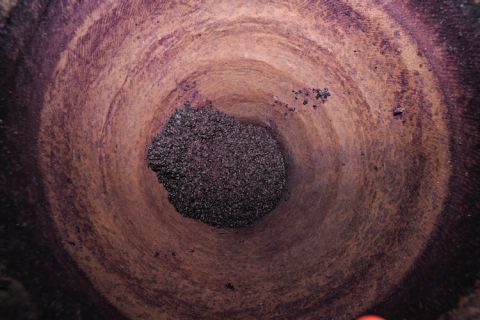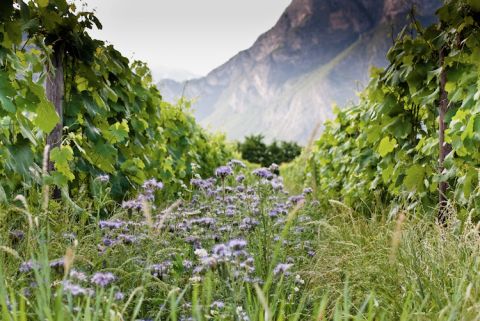Sgarzon 2020 from €28, £39, 69.50 Swiss francs
Sgarzon 2019 from €24.40, 32.96 Swiss francs, HK$334, £35, $50.99, AU$78, 5,592 roubles
Morei 2020 from €26.90, £38, 39 Swiss francs, CA$62
Morei 2019 from €24.40, 33 Swiss francs, CA$47, 389.90 Norwegian kroner, $51.90, £40, AU$78, SG$70.40
It was an impossible choice: Morei or Sgarzon?
These two single-vineyard Foradori wines from the Campo Rotaliano, or the Rotaliano Plain, ‘a sort of indentation’ in the Adige Valley in the Dolomites, ‘wedged between the mountains’, according to the Foradori website, are both utterly captivating. When I was tasting them, I could not think of anything else. They required my complete attention and gave complete pleasure in return.
They are made in equal volumes (12,000 bottles of each) and are roughly the same price, despite the variations in the international prices listed above. The 2019 and 2020 vintages of both wines are available, depending on where you live, the 2020 more likely in Europe and the 2019 in the US.
In the end I just couldn’t choose so I will leave that choice to you. Better still, buy one of each and see how both different and similar they are. I may have scored the Morei slightly higher than the Sgarzon, mainly for its greater density and potential longevity, but I found all of these wines delicious and enthralling.
Teroldego is a very old Trentino red wine grape variety, first documented in the 15th century, that we describe in Wine Grapes as a ‘Well-connected, revived Trentino speciality’. Elisabetta Foradori and her late husband Rainer Zierock were key players in this revival. DNA profiling by Vouillamoz and Grando* has shown it to be an uncle/aunt of Syrah, and I certainly see an echo of Syrah in these particular wines, if not in less refined examples of Teroldego. (See this pedigree diagram from Wine Grapes for Teroldego’s Italian connections.)
The Campo Rotaliano, as the Foradori site explains, is ‘a flood plain formed by the confluence of the Noce River into the Adige River: a 400-ha [990-acre] triangle surrounded by massive cliffs … The Noce River has fashioned the plain’s geography, conveying downstream rocks from the many mountains it touches.’ This has resulted in very different soils. This and the slight variation in climate are what make the difference.
Both Morei and Sgarzon are made in the same way in this lightly windy but sunny location: the 40-year-old vines are farmed biodynamically (certified by Demeter since 2009 and a member of respekt-BIODYN from 2021), harvested by hand, fermented and aged eight months with the skins in Spanish clay vessels known as tinajas. Elisabetta Foradori wanted to be able to use amphorae made from local clay but analysis showed it to be unsuitable because of the metal content. Her eye for detail is key.
When I met Foradori at the Amphora Day tasting in southern Portugal recently (more on this in the new year), she told me she felt that ‘clay multiplies the messages’, be they good or bad, and that it ‘fits with the purity of Demeter [ie biodynamics]’.
Purity is a key word for these wines. While Morei (meaning ‘dark’ and pictured at the top of the article, by Andrea Scaramuzza), is in the middle of the Campo and more stony, limiting the vigour of the vines, Sgarzon (pictured below; sgarzi refers to a lot of young shoots), has sandier soils, is further south and closer to the mountain so that the sun sets earlier. Both vineyards are just 2.5 ha (6.2 acres).
The wines of Morei therefore tend to be a little more dense and more reticent, Sgarzon a little lighter and with a slight floral note. But both wines are marked by freshness, immensely fine, dry tannins, and either dark-red or dark fruit, with a dry, stony/rocky edge to them that adds further refinement and elegance. They are pure and persistent and evolve in the glass.
I’ve recommended both the 2019 and the 2020 of both wines as both are available. The 2020s are probably more approachable than the 2019s, which should age longer in bottle and may need another year or so to reveal themselves more fully, and the Sgarzon is a little more open than the longer-lived Morei. See my more detailed notes on Morei 2020, Morei 2019, Sgarzon 2020, Sgarzon 2019.
Azienda Agricola Foradori was founded in 1939 by Elisabetta’s grandfather, and she has now handed over the winemaking to children Emilio, Theo and Myrtha Zierock. While still involved with winegrowing, Elisabetta has embarked on a new adventure: making cheese from the milk of the seven cows that are part of their biodynamic farm. They also have another farming project in the foothills of Monte Baldo in the south of the Trentino region, focused on breeding Tyrolean Grey cattle for milk production and vegetable farming.
These wines are not inexpensive but the quality is outstanding for the price. If you want to be captivated in mind and heart, try them, one by one or side by side. Maybe you will find it easier to choose than I did.
Foradori wines are imported into the US by Louis Dressner Selections and into the UK by Newcomer Wines.
*J F Vouillamoz, M S Grando, ‘Genealogy of wine grape cultivars: Pinot is related to Syrah’, Heredity 97 (2006): 102–10; https://doi.org/10.1038/sj.hdy.6800842
















